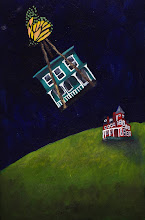



There are some buildings which become the icon for the entire city. With Manhattan's density, it isn't simply one building that stands out, but the cumulative vertical effect of skyscraper next to skyscraper. Philip Johnson's Chippendale detail on the AT&T building is barely visible from the street, but soon became part of the post-modern movement in architecture. It was only from this 36th floor window that I was able to get a good look and snap a pic.
The Guggenheim, recently renovated, is another architectural 'must-see' for its graceful exterior and its inspired floor plan. Currently housing a Frank Lloyd Wright exhibition, Wright's desire to establish a modern and distinctly American form of architecture is detailed in his beautiful drawings and in the handful of models on display. What was most interesting about the show were the residential floor plans as evidence of how our homes have evolved. Most significantly is the change in the placement of the kitchen. What is now the center of a contemporary home for cooking, eating, and socializing, Wright relegates the kitchen into a separate space meant just for food preparation with little to no connection to the living space. What remains true, however, is his desire to place the house on the site be be best integrated with nature.
Another great, but often overlooked NYC building, is the Park Avenue Armory between 66th and 67th street, built for New York State’s Seventh Regiment of the National Guard, the first volunteer militia to respond to President Lincoln’s call for troops in 1861. The building was completed in 1880. Members of what was known as the “Silk Stocking” Regiment included New York’s most prominent Gilded Age Families including the Vanderbilts, Van Rensselaers, Roosevelts, Stewarts, Livingstons and Harrimans. The Armory’s drill hall, one of the city's largest unobstructed interiors, uses industrial steel arches for support, reminding one of what Penn Station had been. The vast 9,000 square foot space was used most recently for the Ernesto Neto exhibition, whose fluid transparent forms were nearly dwarfed in the enormity of the space.
I hope to spend a good portion of this summer continuing the search for great NYC architecture, so if you have any suggestions, please drop me a note!






